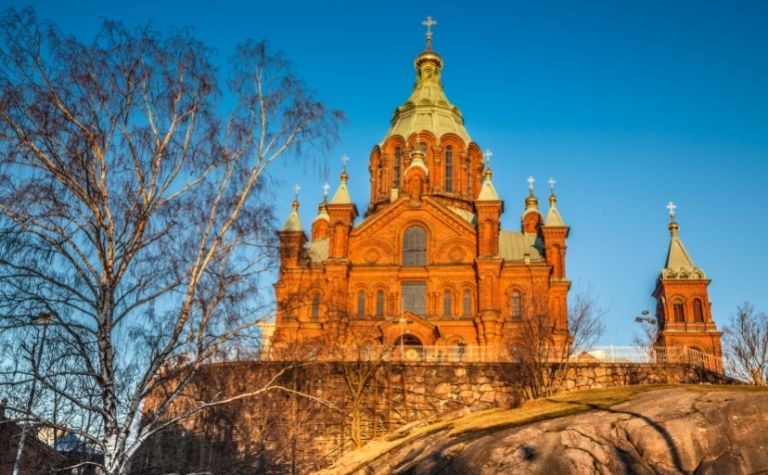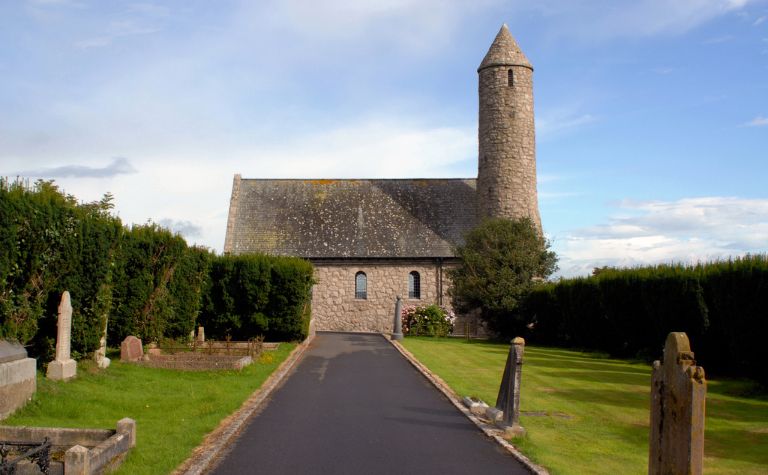The Episcopal Church and the Eastern Orthodox tradition are two prominent branches of the Christian faith. Many people have heard the names “Episcopal” and “Orthodox” used to describe churches, people, and beliefs but aren’t sure what the similarities and differences are between them. How do these Christian traditions compare?
The Episcopal Church, an American-born tradition that is part of the worldwide Anglican Communion with roots in England, is halfway between Roman Catholic and Protestant. Eastern Orthodoxy is neither Catholic nor Protestant, but along with those traditions, it’s the third historic branch of the Christian faith.
Where do the terms “Episcopal” and “Eastern Orthodox” come from, and what do they mean? How do the traditions’ beliefs about God, the Bible, the Holy Spirit, and the Second Coming compare? Keep reading to learn the answers to these questions and others.
Also, see Episcopalian vs Pentecostal: What’s the Difference? to learn more.

Episcopal Church and Eastern Orthodoxy: Comparison
There are many cultural differences between the Episcopalian tradition, which is mostly found in America, and Eastern Orthodoxy, whose historical roots are in Eastern Europe. Yet, because both traditions are Christian, they have important similarities.
| Episcopal Church | Eastern Orthodox | |
|---|---|---|
| Origin | The Anglican tradition dates to the time of King Henry VIII (1491-1547) and his protests against the Catholic church. Anglicanism arrived in America with settlers from England. The label “Episcopalian” dates to the time of the Revolutionary War (1775-1783) when the names “Anglican” and “Church of England” were out of favor. | In 1054 A.D., about 500 years before the Protestant Reformation, a split occurred between the Eastern and Western churches. The division is commonly referred to as the East-West schism. |
| Meaning of the name | From the Greek word for “overseer” and the Latin word for “bishop,” the term refers to a form of church government that locates ecclesiastical authority in the office of bishop as opposed to the papacy or congregational membership. The term also describes the largest tradition in the Anglican Communion in America. | “Eastern” refers to the geographical area of the Orthodox tradition, whose capital is Constantinople. The “Western” church refers to Roman Catholicism, whose capital is Rome. “Orthodox” comes from a Greek word meaning “correct belief.” |
| Branch of Christianity | Because its part of the Anglican Communion, many consider Episcopalianism to be halfway between Protestant and Catholic. Many theologians and historians posit that a church can’t be “halfway Catholic,” so it’s best to consider the tradition Protestant with aspects of Catholicism woven into certain churches. | Eastern Orthodox is the common name for this branch of the Christian faith. The other two historic branches are Catholicism and Protestantism. |
| Approximate membership | The Anglican Communion has a membership of 110 million worldwide. The Episcopal Church in America, after seeing rapid declines in recent decades, has about 2 million members. | 220 million worldwide |
| Early influencers | King Edward VI (1537-1553), Queen Elizabeth I (1533-1603), theologian Richard Hooker (1554-1600) | Patriarch Michael I Cerularius of Constantinople (1000-1059); the Three Pillars of Orthodoxy: Photios I of Constantinople (810-893), Mark of Ephesus (1392-1444), and Gregory Palamas (1296-1359) |
| Significant writing outside the Bible | The tradition affirms the Apostles’ Creed and the Nicene Creed. The Book of Common Prayer is also a pivotal document to the heart and identity of the tradition. | The teachings of the first seven ecumenical councils of the church from the 4th to 8th centuries; the Apocrypha or Deuterocanonical literature; the Septuagint, a Greek translation of the Old Testament; the Peshitta, a Syriac translation of Bible |
| What are the largest denominations in the tradition today? | The denomination called the “Episcopal Church” is the largest in the tradition by a significant margin. Denominations and churches have split over theological, political, and social issues. Examples of contentious topics include women in ministry, allegations of devaluing Scripture, and issues related to same-sex marriage and gender identification. | Bodies within Eastern Orthodoxy are commonly referred to as national churches, not denominations. The largest are The Russian Orthodox Church, The Romanian Orthodox Church, The Greek Orthodox Church, and The Serbian Orthodox Church. |
Historically, the Protestant, Catholic, and Eastern Orthodox branches of the Christian faith have many similarities, including belief in the virgin birth of Christ, his physical resurrection from the dead, and his Second Coming. The traditions also have significant disagreements, which may be summarized in three general points (more details below).
- The procession of the Holy Spirit: Eastern Orthodoxy believes that the Holy Spirit proceeds from the Father alone, and not the Father and the Son, as Protestantism and Roman Catholicism contend. The phrase “and the Son,” also referred to as “the filioque clause,” which is the original Latin term, was inserted in the Nicene Creed in 589 A.D. at the Synod of Toledo, Spain. The Orthodox Church did not participate in the synod and strongly disagreed with the addition.
- The role of the pope: Protestantism does not recognize the authority of the pope as the Catholic Church does. Eastern Orthodoxy honors the pope but does not recognize his authority.
- The recognition of ecumenical councils: Ecumenical councils are meetings that have been held throughout church history to articulate unity of doctrine among Christians. The councils are applications of Jesus’ prayer for unity (John 17:21) and the example of the meeting in Jerusalem as recorded in Acts 15. The early church called councils to discuss important doctrines like the Trinity and Christology. Protestantism recognizes many beliefs expressed in the councils. Roman Catholicism recognizes 21 councils. Eastern Orthodoxy recognizes the first seven, which occurred from the 4th to 8th centuries.
Also, see Episcopalian vs. Roman Catholic: What’s the Difference? to learn more.

Episcopalian and Orthodox Christianity: Similarities and Differences
| Episcopal Church | Eastern Orthodox | |
|---|---|---|
| Scripture | Historically, Episcopalianism has valued Scripture. Recently, liberal and progressive congregations have decentralized Scripture. People can read deutero-canonical literature or the Apocrypha, but they can’t be used to establish doctrine. | The Bible is the source of doctrine and practice in Eastern Orthodoxy. The Orthodox Church does not hold to Sola Scriptura (“scripture alone”) like Protestantism does because it believes the church defines Scripture and determines its meaning. Orthodox churches include the deutero-canonical books in their Old Testament. |
| God | Episcopalians believe in the Trinity; there is one God who exists in three persons. The Father, Son, and Holy Spirit are each fully divine. | Eastern Orthodoxy believes that God is Triune, but unlike Protestantism, it does not believe that the Holy Spirit proceeds from the Father and Son but only from the Father. |
| Christ | Historically, Episcopalianism has affirmed that Jesus is the second person of the Trinity. He is God in human flesh. He is 100% God and 100% man. Jesus was born of a virgin, lived a sinless life, died as an atonement for sin, was physically resurrected on the third day, and ascended into heaven. | The second person of the Trinity became a man in the person of Jesus of Nazareth, according to Orthodox beliefs. Jesus was virgin-born and lived a sinless life. Orthodoxy rejects the Protestant belief that his death on the cross was substitutionary. The Orthodox Church affirms the historical, physical resurrection of Christ from the dead. |
| Salvation | Episcopalianism’s roots in Anglicanism are closer to Calvinism than Arminianism. However, Arminianism grew to characterize and influence the tradition more. Today, liberal and progressive congregations are ecumenical and inclusive of other religions, not just other denominations. | The Orthodox view of salvation is based on 2 Peter 1:4 (see below) called “deification,” which refers to a process of becoming more like God. Deification does not mean that believers will become exactly like God in his essence. |
2 Peter 1:4, “Whereby are given unto us exceeding great and precious promises: that by these ye might be partakers of the divine nature, having escaped the corruption that is in the world through lust.” (KJV)

| Episcopal Church | Eastern Orthodox | |
|---|---|---|
| View of the Ordinances, Sacraments | All Episcopalian expressions recognize baptism and the Lord’s Supper. Those who have convictions that align with the high church recognize the other five that Catholicism does. The Anglican-Episcopalian tradition teaches that the sacraments are a means of grace, as in Catholicism. | Eastern orthodoxy prefers the term “sacred mysteries.” Orthodox teaching conventionally lists seven: communion, baptism, Chrismation, confession, unction, matrimony, and ordination. |
| Baptism | Clergy baptizes infants and adults; baptized individuals are “grafted into the church.” | Bishops and priests administer baptism, in which subjects are immersed three times, once for each member of the Trinity. Eastern Orthodoxy teaches that baptism regenerates a person and makes them a member of the true church. |
| Communion | Christ is present in the elements, but there is a mystery to it. The tradition doesn’t fully embrace Catholicism’s theology of the Eucharist but affirms that consuming the elements is more than simply a memorial practice. | The Orthodox Church teaches that the bread and cup literally turn into the body and blood of Christ, but it does not attempt to explain exactly how it occurs. |
| Icons | The Episcopal Church does not recognize or use icons as the Eastern Orthodox Church does. | An icon is a physical representation of a holy person or thing. The Eastern Orthodox tradition, throughout its history, has strongly defended the use of icons, which they believe enhance people’s devotion to God. |
| Holy Spirit | The Holy Spirit is the third person of the Trinity. He is fully divine. Episcopalians are historically cessationists (e.g., they don’t speak in tongues), yet some small communions practice charismatic worship (e.g., International Communion of the Charismatic Episcopal Church). | The Holy Spirit is the third person of the Trinity and is fully God, according to Orthodox teachings. The Spirit is distinct from the Father and the Son. “Christ sends the Holy Spirit who proceeds from the Father,” according to Orthodox teaching. |
| The Return of Christ | Episcopalians believe in the Second Coming of Christ. | Eastern Orthodoxy believes in the return of Christ but does not have a fully developed eschatology as many Protestant traditions do. This is due in part to the Orthodox church’s belief that the book of Revelation is a mystery. |
| Millennium | The tradition’s eschatology is Amillennial, as opposed to Premillennial or Postmilennial. | The millennium is not a focus of Orthodox theology. Orthodox theologians that have expressed beliefs on the topic reflect Amillennial views. |
Also, see Episcopalian vs. Anglican: What’s the Difference? to learn more.
Related Questions
Episcopalian and Baptist are two of the largest branches of the Christian faith in America, though churches belonging to each tradition can also be found around the world. Many people know that...
Many people have heard of the Episcopalian and Methodist denominations but don't know the differences and similarities between their respective churches. People may also be aware that both traditions...
